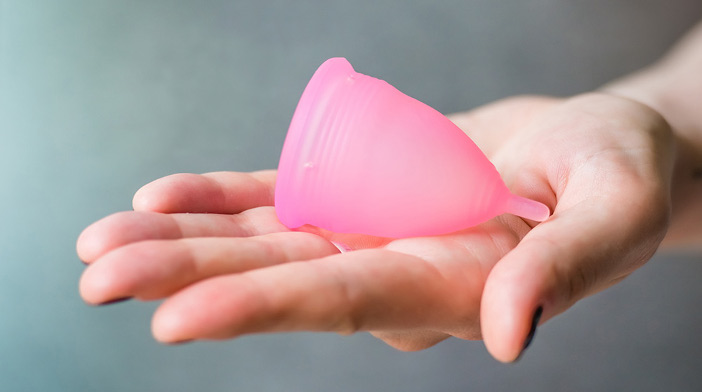While I was in New York last week, I stopped by Whole Foods (as I always do—love you, Whole Foods!) and picked up a Diva Cup. What’s that? It’s the most popular of the menstrual cups, a green alternative to tampons and pads. Made of rubber or silicone, menstrual cups are having a moment—again.
I used one of these over a decade ago when I was a total crunchy, raw vegan. I remember thinking they were great and I forget why I stopped using them. But I did and it’s been tampons and pads all over again, which have never been an ideal solution.
Shall we count the ways?
Environmental: Both the manufacture and disposal of tampons and pads are significant in terms of their environmental impact. There’s the high cost of cotton production (water, pesticides, fertilizers) for tampons. There’s also the fossil fuels used to make the plastics for applicators and pad backings. A woman typically throws away 300 pounds of feminine hygiene products in her lifetime, making up 0.5 percent of landfill waste. The plastic liners of pads last indefinitely while plastic applicators can take 25 years to break down in the ocean, where they’re often swallowed by—and kill—marine life. PLEASE: Do not flush plastic applicators!
Health: Unless you’re using non-bleached, rayon-free, organic cotton pads and tampons, you’re putting pesticide-ridden cotton that’s been bleached in or near your lady parts. The bleaching produces dioxin (i.e. a contaminant found in Agent Orange); rayon also has trace amounts of dioxin. Dioxin is an endocrine disrupter that can cause certain cancers and affect reproduction and development (at least in animals.) The FDA says the dioxin health risk from tampons is negligible, but when a woman uses 8,000 to 17,000 tampons in her life, that’s a huge amount of exposure and buildup. Frankly, it’s frightening.
Back to the menstrual cup: There doesn’t seem to be any good reason not to use this green, healthy alternative to what’s looking like an ecological and biological disaster.
I’m going to be upfront with you. It’s kind of gross. Especially if you’re squeamish about blood and touching yourself. The cup has to be folded, then inserted, where it opens back up and creates a seal, capturing the blood. After several hours (up to 12), you take out the cup, dump the blood, wash and reinsert. For someone like me who’s not particularly squeamish about this stuff, it’s NBD. But I can see how it might be a little too hands-on and gynecological for some.
But wow, is it convenient! You really can leave it in for up to 12 hours, which is a godsend for a busy woman. I don’t know how many times I’ve forgotten to carry extra tampons in my purse and there’s leak issues as well as the stress of worrying about Toxic Shock Syndrome and losing my limbs—this happened to a friend of a friend, I swear. (Urban myth alert…)
I’ve only used the Diva Cup for one cycle so far, but it’s as reliable and comfortable as I remember. Especially for heavy-flow days, it is so wonderful not to have to change a tampon every couple of hours. Once the cup is in place, you don’t feel it and I had zero leakage. One slight issue: Sometimes the cup would stay folded after insertion and I’d have to fiddle around with it—inside my vagina—to get it to open. Again, not a deal breaker but could be bothersome for others.
The only other question is what to do in a public bathroom? I remember being perplexed about this years ago and it’s true that French toilets often don’t have sinks in them. Some suggestions are to have a bottle of water or bring a wet paper towel into the stall with you. Otherwise, try to time when you insert the cup to right before you’re going out. Most likely, you’ll be home before you need to empty it.
I’m really happy with my Diva Cup. I got it for about $40 at Whole Foods, but Vivre Mieux is selling it for €25! At either price, it’s a bargain compared to how much tampons, pads and liners cost annually (besides their environmental price). My original menstrual cup was the Keeper and came in latex, which can last up to 10 years. The Diva Cup is made out of medical-grade silicone and the recommendation is to replace it yearly, but even the manufacturers say it’s up to you how often you want to replace it. And the Diva Cup and the Keeper aren’t the only options. There are many different brands of cups with many user reviews so you can find the one that suits you best.
Would I recommend a menstrual cup? Yes, resoundingly! Do it for yourself. Do it for the planet.
Images via Shutterstock and Lunette






2 Comments
I Couldn’t agree more. Never going back to tampons. Have been using the French made Fleur cup for quite a while now. They can be ordered on Amazon.
Aren’t cups the best? I’m kicking myself for stopping using them years ago. I could have saved so much money, the environment, even my health if I’d just continued using one. I want to try the Fleur cup. Thanks for sharing!